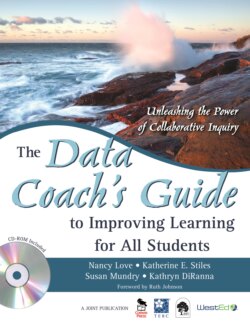Читать книгу The Data Coach's Guide to Improving Learning for All Students - Katherine E. Stiles - Страница 55
Ensure Timely Access to Robust Data Sources: The Democratization of Data
ОглавлениеBy the end of the 2004–2005 school year most grade levels had given some common assessments and had tried to compile the data. We did this using Math-and-Science Partnership project time during the school day. This was a long process because we had to compile the data by hand. We had no time left to actually dive into it and discover what we needed to change in terms of instructional strategies. All that changed with the purchase of the Principia software package. Now we are able to use that same time to make data-driven decisions.
—Ann Wacker, Mathematics and Data Coach Plain Local Schools, Canton, Ohio
In the early days of the Using Data Project, staff confronted a confounding obstacle: The very people who could make the best use of student-learning data—the teachers—had the least access to the data. Test data were “under lock and key” and were the “private property” of the research, assessment, or other district office. Teachers often did not receive assessment data at all, or received them so long after the tests were administered that they were not even teaching the same children. Project staff and district and school-based collaborators had to advocate strongly to “democratize the data,” giving teachers access to their students’ results. Thankfully, times are changing as more districts put timely data systems into place that make a variety of school data readily available to teachers.
However, even with the best data management systems, data access can still be problematic. For example, many states do not report data at the item level or release test items for teachers to analyze. Yet item-level data (see Task 9), when used in conjunction with the actual test items, are among the most useful data teachers have to improve their instruction.
One way around this problem is for schools to make or buy their own assessments and assure that teachers have just-in-time access to both the item-level results and the items themselves. This is one reason why common benchmark assessments are so important to improvement. Because they lend themselves to item analysis, are administered periodically throughout the school year, and align with local standards and curriculum, they can fuel collaborative inquiry.
But the data access problem may not yet be solved. The next challenge is to get results from common assessments to teachers fast, within a few days—in time for them to actually do something about them. Fortunately, this problem has a simple technological solution: inexpensive software programs and scanners, which can scan about 200 tests per hour, placed in easy access of the Data Coach. When put in place in participating Using Data schools, these machines removed the data bottleneck and got collaborative inquiry moving.
The good news is that much of the data that fuels collaborative inquiry is not dependent on expensive data management systems. Simple scanners will do the job of churning out the item-level data on local assessments. Some of the most robust data sources, formative classroom assessments and common assessments such as student work, mathematics problems of the week, and science journals, require no data management system at all—just teachers collecting their students’ work and sharing it with colleagues. While data management systems facilitate data access, they are not a prerequisite for collaborative inquiry.
